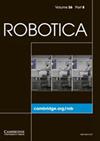Shape-controllable inverse kinematics of hyper-redundant robots based on the improved FABRIK method
IF 2.7
4区 计算机科学
Q3 ROBOTICS
引用次数: 0
Abstract
Abstract Hyper-redundant robots have good prospects for applications in confined space due to their high flexibility and slim body size. However, the super-redundant structure brings great challenges for its inverse kinematics with shape constraints. Unfortunately, traditional Jacobian pseudo-inverse-based inverse kinematics method and forward and backward reaching inverse kinematics (FABRIK) method are difficult to constrain the arm shape and realize trajectory tracking in confined spaces. To solve this problem, we propose a shape-controllable FABRIK method to satisfy the given path and shape constraints. Firstly, the kinematic model of the hyper-redundant robot is established, and the canonical FABRIK method is introduced. Based on the preliminary works, the single-layer improved FABRIK method is developed to solve the position and pointing inverse kinematics considering path environment and joint angle constraints instead of two-layer geometric iterations. For tracking the desired end roll angles, the polygonal virtual arm is designed. The real arm roll angle is achieved by controlling its winding on the virtual arm. In this way, the shape can be controlled. Finally, we compare the proposed method with other three approaches by simulations. Results show that the proposed method is more efficient and the arm shape is controllable.基于改进FABRIK方法的超冗余度机器人形状可控逆运动学
超冗余度机器人以其高柔韧性和超薄的体型在有限空间中具有良好的应用前景。然而,超冗余度结构对其具有形状约束的逆运动学提出了很大的挑战。然而,传统的雅可比伪逆运动学方法和正向后逼近运动学(FABRIK)方法难以约束臂形,难以在受限空间中实现轨迹跟踪。为了解决这个问题,我们提出了一种形状可控的FABRIK方法来满足给定的路径和形状约束。首先,建立了超冗余度机器人的运动学模型,并引入了典型的FABRIK方法。在前期工作的基础上,提出了考虑路径环境和关节角度约束的单层改进FABRIK法,取代了两层几何迭代法求解位置和指向逆运动学。为了跟踪期望的端滚角,设计了多边形虚拟臂。通过控制手臂在虚拟手臂上的缠绕来实现真实手臂的滚转角。这样,形状就可以被控制。最后,通过仿真将该方法与其他三种方法进行了比较。结果表明,该方法效率高,手臂形状可控。
本文章由计算机程序翻译,如有差异,请以英文原文为准。
求助全文
约1分钟内获得全文
求助全文
来源期刊

Robotica
工程技术-机器人学
CiteScore
4.50
自引率
22.20%
发文量
181
审稿时长
9.9 months
期刊介绍:
Robotica is a forum for the multidisciplinary subject of robotics and encourages developments, applications and research in this important field of automation and robotics with regard to industry, health, education and economic and social aspects of relevance. Coverage includes activities in hostile environments, applications in the service and manufacturing industries, biological robotics, dynamics and kinematics involved in robot design and uses, on-line robots, robot task planning, rehabilitation robotics, sensory perception, software in the widest sense, particularly in respect of programming languages and links with CAD/CAM systems, telerobotics and various other areas. In addition, interest is focused on various Artificial Intelligence topics of theoretical and practical interest.
 求助内容:
求助内容: 应助结果提醒方式:
应助结果提醒方式:


